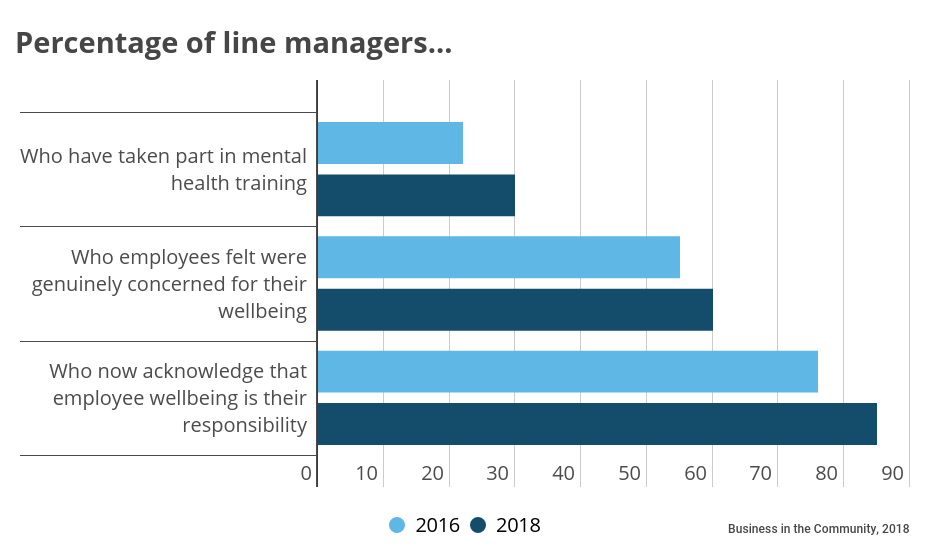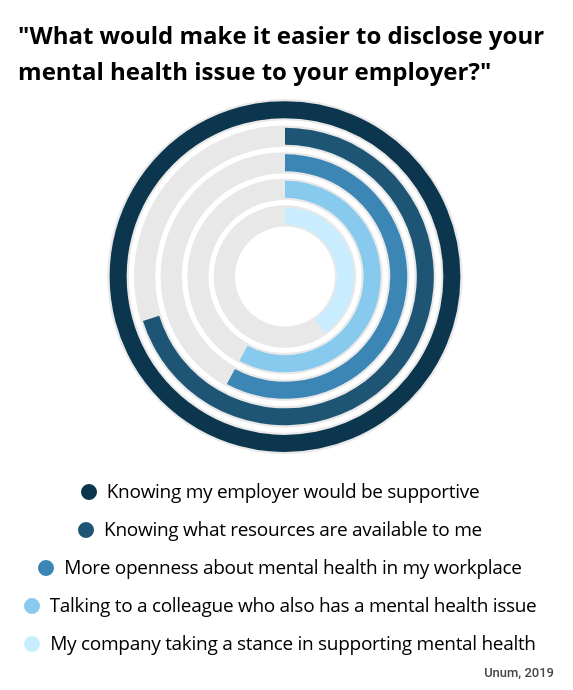In spite of the increased awareness of mental health issues, many employees still do not feel comfortable discussing their own experiences at work, for fear of damaging reputations or encountering more serious repercussions.
“According to the Mental Health Foundation, 45 per cent of employees who have been diagnosed with a mental health problem, and taken time off work as a result, gave another reason for doing so” explains Dr Zakir Abbas, Chief Medical Officer at employee benefits provider, Unum. “Clearly, there is some way to go before employees feel comfortable discussing their mental health, and employers feel well equipped to support them.”
Helping employees who are unwilling to talk about their struggles is a daunting task, but it is an employer’s responsibility to create a workplace where people feel they can be open. Not only do business leaders have a duty of care to their workers, but a lack of action can have serious implications for the organisation itself. “Most employers would wish to support their employees when ill, but mental health also affects the bottom line” says Dame Carol Black, expert adviser to Public Health England. “A 2018 study showed that one third of productivity loss is related to work stress and lifestyle choices, and the average productivity loss per employee translated to £81 bn annual cost to the UK economy.”
So how should business leaders be supporting employees with mental health problems?
Managing and supporting mental health at work
‘You don’t leave a job, you leave a manager’. So runs the old adage, and it rings particularly true when it comes to supporting employees with mental health problems.
Managers occupy the perfect position to help colleagues in the workplace, having both a keener understanding of an employee’s day-to-day wellbeing, and a line to those above them who can sanction the measures needed to support someone suffering from mental ill-health.
Unfortunately, many managers receive insufficient training, not only for dealing with employees’ mental health challenges, but even for managing people in the first place. “When I was working in corporate, there were people who had been individual contributors and suddenly found themselves in a management role, having received no training” says Angela Armstrong, founder of leadership development firm, Armstrong, which teaches executives how to become sustainable leaders. “Employers say ‘we need a degree from you to do this specialist role’ but only send people on a half-day course to be a manager. It isn’t enough.”
More importantly still, managers must feel supported when it comes to their own mental health, in order to offer that support to their colleagues. Caitlin Rimmer, a content and SEO specialist at digital marketing agency, AddPeople, suffers from PTSD and depression and claims good management has made all the difference to their ability to work. “I had a manager in a past job who suffered from intense depression, but there was no support there for him so he just had to deal with it. One of the great things about AddPeople is that the managers themselves are supported so they can really look after their staff.”
True human connection is irreplaceable, so it’s crucial that time is made for the social side of work, no matter how many of your employees work remotely
The importance of human connection for wellbeing
As well as encouraging both formal and informal check-ins between managers and managees, organisations must acknowledge and build on the power of basic human connection when supporting employees with mental health problems.
According to a 2018 study by Gallup, employees with a best friend at work can be up to seven times as engaged and considerably more productive. When one considers the number of hours we spend at work, having a “work family” makes sense - socialising with our peers is part of what makes us human. “Getting on with the people you work with helps massively,” says Mx Rimmer. “My colleagues are my friends. The five minutes a day I get to spend being an idiot with them makes up for the many hours I spend being a sensible person!”
Perhaps more importantly, making these “water cooler moments” part of the daily routine creates opportunities to check in with colleagues and understand their state of mind. “One thing that makes a big difference in the workplace is making time for team, for belonging,” says Ms Armstrong. “Technology enables us to work from home a lot more and we’re losing that coffee-room chat that keeps us connected so we can actually look out for our colleagues and notice when they’re out of sorts.” True human connection is irreplaceable, so it’s crucial that time is made for the social side of work, no matter how many of your employees work remotely.
Listening is key to supporting employees
These real-world relationships feed into another vital way of supporting employees with mental health problems: listening. The most meaningful and helpful way to fight the stigma of mental illness is to encourage all members of staff to be willing to listen when a colleague is talking about their experiences - and listen with empathy.
“We don’t need to understand every condition, or every person, to be good, human listeners,” says Rob Stephenson, activist and founder of InsideOut, a social enterprise fighting to end the stigma around mental ill-health. “We’re not all psychotherapists so we shouldn’t look to ‘solve’ anything. We just need to become better active listeners in the workplace, so we can say ‘OK, I can see you’re struggling here, let’s go for a walk and you can tell me about it.”
The act of listening - rather than telling - is especially crucial when it comes to aiding an employee’s recovery. “Having adult conversations is so important,” explains Ms Armstrong, “because the individual must participate in getting themselves better. Simply reminding them they are in control goes a long way to help people be more solution-seeking.”
One third of productivity loss is related to work stress and lifestyle choices
Creating a workplace mental health plan
Once you have established what an individual needs, it is significantly easier to design a mental health plan which will actually help them. This should involve concrete steps, tailored to their needs, with the aim of getting them back to work in a sustainable way.
Possible features of this workplace mental health plan can be offering time off for therapy sessions and doctor’s appointments, flexible working hours, more or less of a focus on specific projects, or the option to work from home more. But it is equally important to help educate people around how they can prioritise their mental health from a lifestyle perspective.
“As someone who experiences bipolar disorder, I know that exercise is priority one, sleep is priority two, connection with family and friends is really important,” says Mr Stephenson. “But I’ve worked out what works for me with a process of trial and error over a period of fifteen years.” If the employee in question has never struggled with their mental health before, they may not yet know what works for them - it could be learning to balance stress with adequate recovery time, finding a sense of purpose, or recognising the positive impact of their work.
Ultimately, the best way of supporting employees with mental health problems is to prevent issues before they reach crisis levels and lead to employee absences. This means fostering a culture which promotes positive mental health in the workplace, rather than simply supporting those colleagues who are already suffering.
5 simple steps for supporting employees with mental health problems
- Invest in good, up-to-date management training
- Commit to having regular social activities for all staff
- Be prepared to listen when approached by an employee who is struggling
- Create an ongoing personalised mental wellbeing plan for each individual
- Have resources in place to help people understand what they really need
Related articles:
How to create a mentally-healthy workplace

Managing and supporting mental health at work
The importance of human connection for wellbeing

